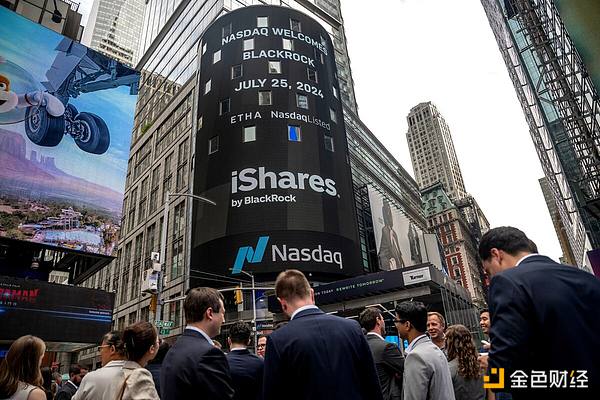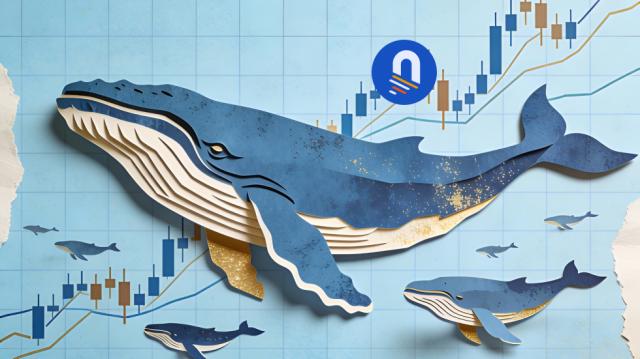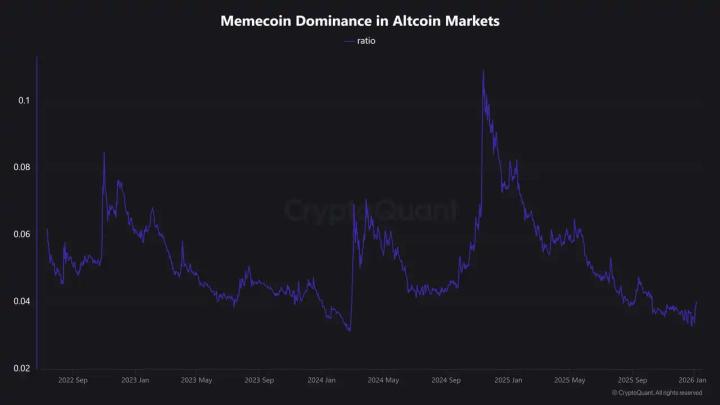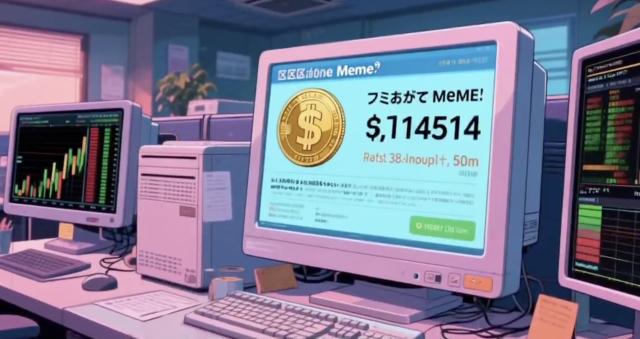Author: Alexander Sugiura, Adriana Tapia Zafra, Bloomberg; Translated by: Baishui, Jinse Finance
Nearly $13 trillion is invested in exchange-traded funds (ETFs). These ETFs mirror the S&P 500. There are gold ETFs, bitcoin ETFs, and even vegan ETFs. How did this market become so large and diverse? And what does it consist of?

BlackRock’s iShares Ethereum Trust ETF (ETHA) saw $248 million in trading volume, one of the highest first-day volumes ever, according to Bloomberg Intelligence. Photographer: Victor J. Blue/Bloomberg
Today on the podcast, we continue with Eric Balchunas, Senior ETF Analyst at Bloomberg Intelligence and co-host of the Trillions Podcast. He tells host David Gura about the unlikely duo who created the first-ever ETF as a last-ditch effort to save a troubled exchange. And Katie Greifeld, co-host of Bloomberg ETF IQ and Money Stuff, analyzes the current booming market and outlines which ETFs are safe investments and which are best not to invest in.
The following is a transcript of the conversation:
David Gura: Sarah.
Sarah Holder: David.
Gura: I want you to come into the studio with me today because I have to ask you about ETFs and what you know about them.
Holder: Okay, ETFs… I think what I usually hear is don’t bother researching all these individual stocks.
Gura: Yeah.
Holder: Just find an ETF and put all your money into that ETF basket.
Dave Nadig: These things can really change the way we think about investing.
Zachary Mider: We have this huge vulnerability, let’s exploit it in new and creative ways.
Emily Graffeo: So over the last six months, 94% of ETFs have had positive returns.
Mider: You know that's a big tax advantage for a lot of people.
Gura: But, Sarah, to be honest, I’m not entirely sure how they work and why they’re so popular.
Holder: Yeah, I'm not sure either, why are they such a good investment, David? What's in them? How are they different from a mutual fund or an index fund?
Gura: These are great questions, Sarah, I have the same questions.
Holder: Thank God, I needed it.
Gura: This is our series where from time to time we analyze the biggest parts of the financial system. We'll look at how they came to be and what they mean for all of us. Even if you're a financial expert.
Holder: Or if you just want to understand more about what's actually in your portfolio.
Gura: I promise there will be something for everyone!
Holder: I’m Sarah Holder.
Gura: I'm David Gura. Exchange-traded funds (ETFs) are one of the stars of today's investing world. They have Meryl Streep status: They are respected, loved and...adored by professional and amateur investors alike.
Since their inception more than 30 years ago, ETFs have become one of the world’s most popular investments. But to understand how ETFs have grown and prospered, it’s first important to understand their origins.
At Bloomberg, we are fortunate to have an ETF expert who has been covering ETFs for decades: Eric Balchunas.
Eric Balchunas: I am a Senior ETF Analyst, I write, analyze, and discuss ETFs and lead a team of about 10 people around the world who do the same thing.
Gura: Do you have a favorite ETF?
Balchunas: It's hard to pick a favorite. You know I love this stuff. I wouldn't say it like my kids would, I wouldn't go that far.
Gura: Eric said that ETFs were born during...one of the darkest periods on Wall Street.
James Limbach: This is the worst day in stock market history by any measure.
Balchunas: On Black Monday in October 1987, the stock market dropped 24%. I mean, in percentage terms, that's a huge number. That's a quarter of the stock market being wiped out.
Limbach: The Dow Jones Industrial Average's drop was almost three times the previous single-day record.
Gura: After that crash, the Securities and Exchange Commission (SEC) wrote a report analyzing the causes of the crash and making some recommendations on how to avoid another crash.
Hidden in the middle of the report was a modest recommendation from SEC lawyers, Eric said.
Balchunas: What if we came up with some kind of market basket instrument that would trade on the New York Stock Exchange under our supervision?
Gura: Two traders, Nate Most and Steve Bloom, do not work for the New York Stock Exchange, but for its competitor, the American Stock Exchange.
Most is in his 70s. He is a Canadian physicist who served in the military.
Balchunas: Steve Bloom's partner is like the Harvard whiz kid, the prodigy, the rocket scientist, good at math, and younger. So they're an interesting pairing. I think Nate is probably two or three times older than Steve, um, but they work well together.
Gura: The problem is where they work:
Balchunas: At the time, the US stock exchanges were not doing well. They were ranked third in terms of number of listings and trading volume, behind the NYSE and NASDAQ.
Gura: The SEC needed an edge, and that’s when Most and Bloom got their hands on the SEC report, the 800-page postmortem of Black Monday.
Balchunas: Well, Nate and Steve read the book, and they’re really nerdy, and they said, wait a minute. The market basket tool, the SEC is asking for it, and they might approve it. So let’s do it. So no stocks will be listed on our exchange. So why don’t we invent something to create more trading on our exchange?
Gura: So, they started trying to design a market basket trading instrument: something that could be bought and sold on a stock exchange, which acted like a stock, but was actually a basket of stocks: a basket that mirrored the market.
Balchunas: It’s interesting that the idea actually came out of the head of some lawyer at the SEC, and that set the stage for them to find and invent the ETF because they were really desperate.
Gura: But it was not easy to turn this idea into an actual product that could be sold and bought.
Balchunas: So what Nate Most did was a stroke of genius, and the real secret to the ETF was that he remembered his time at the Pacific Mercantile Exchange, where you had something called a commodity warehouse receipt. A commodity warehouse is where you store different commodities. For example, soybean oil. You go there and you put your soybean oil in a locker. You get a receipt for the exact amount of soybean oil. And then you trade the receipt so you don't have to move a lot of commodities.
And then if you had a bunch of receipts and you wanted soybean oil, you could take them to the locker and you could get the oil back. So Nate Most was like, why don't we have receipts, but for S&P 500 stocks. They'll sit in this warehouse, but it's actually a custodian. And then, you get enough receipts and then you can get the stock back. That's called the create redemption process.
So, this is genius because it keeps receipts that can be traded all day without messing up the merchandise. They're actually tied to the physical merchandise in the proverbial warehouse.
Gura: The idea was to create a commodity warehouse for stocks, bonds, or anything else you wanted to bundle together. And then, exchange-traded funds were born.
The first ETF was created by Nate Most and Steve Bloom and included all the stocks in the S&P 500 index. They called it the "Standard & Poor's Depositary Receipt ETF", or SPDR for short.
State Street launched the ETF in 1993, and it attracted a lot of attention.
Balchunas: I remember they had spiders hanging from the ceiling and they were handing out hats. It was a fun day, and well, they traded, and they traded a million shares on the first day.
Gura: We traded a million shares on the first day. Eventually, Eric says, the money invested in ETFs started doubling year over year. That's because people started realizing that ETFs had some real advantages over other bundled investments, like mutual funds or index funds.
Balchunas: Generally speaking, they are cheaper. Right. So that's important. The second thing is that they are transparent, you know, what's going on with them on a daily basis, whereas with other mutual funds and hedge funds, you don't know quarterly or even at all. So the transparency is good.
Gura: What's another big attraction of ETFs? Taxes. ETFs only have to be taxed when they are sold. Mutual funds are taxed every year. But another big advantage of ETFs, Eric believes, is that, unlike many investments on Wall Street, ETFs are very user-friendly.
Balchunas: It's like you have a computer, you have a mouse, and whatever you want to invest in, you just click and buy it. You get it, you own it. That removes a lot of friction. It's almost like Amazon. You know, it's fast, it's good, and it's cheap. It's hard to have all three of those things at the same time.
Gura: Today, about thirty years after the launch of SPDR, there are now thousands of ETFs with trillions of dollars invested.
Later, we'll provide users with a guide to the best, worst, and weirdest ETFs.
Gura: Speaking of the state of ETFs, we found another person at Bloomberg who is obsessed with them. She is Katie Greifield:
Katie Greifeld: I'm the co-host of Open Interest on Bloomberg TV. I write the ETFIQ Brief for Bloomberg News. I also host the TV show Bloomberg ETFIQ and I co-host the Money Stuff podcast with Matt Levine.
Gura: Katie has a lot of work…
Greifeld: I'm so tired.
Gura: But she’s so interested in ETFs that she dropped everything to come talk to us about them. Katie, you told me ETFs are your favorite thing. They are. Explain. Why is that?
Greifeld: I started covering ETFs in January 2020, which, well, January 2020 is a weird time to be in a new space. But the most exciting thing and I think the reason why I love ETFs is that during this time, I've seen the industry grow and evolve at such a rapid pace.
David Gura: Give me some idea of how big the ETF industry has become.
Greifeld: The industry is huge and it's growing. So the market capitalization of ETFs listed in the U.S. is about $9.5 trillion.
Gura: Trillion, starts with T.
Greifeld: Oh, yeah. Uh, about $12.8 trillion worldwide.
Gura: Right now, that's less than half the size of the mutual fund market — the traditional choice for more conservative investors. But ETFs are gaining ground.
A big part of all this growth is that ETFs are seen as safe investments, just like mutual funds. Combined with ETFs' lower fees, they're very attractive to people who want a safe, low-cost place to save their money.
Greifeld: This is one of my favorite charts, and I know we're on the podcast, but if you look at the money flowing into ETFs and out of mutual funds on a yearly basis, you'll see that some years, it's essentially a zero-sum game.
Gura: But not all ETFs are created equal. There are gold ETFs, palladium ETFs, corn futures ETFs, and an ETF that is just Nvidia stock. Now, there are spot Bitcoin ETFs… They are among the most popular ETFs.
Gura: How do they work? Is BlackRock buying a lot of Bitcoin and holding on to it?
Greifeld: That's basically it. Well, I find it helpful to compare it to a spot gold ETF. Because a spot gold ETF does have to buy a lot of gold.
Gura: It has to be backed by something real.
Greifeld: Yes. There are a lot of conspiracy theorists who say that State Street can't possibly have that much gold.
But they do. They store it in a vault in London, underneath the City of London. If you look at the spot Bitcoin ETF. You do have companies like Fidelity, BlackRock buying a lot of Bitcoin. Same thing with spot Ethereum.
Gura: It occurs to me that we're seeing this ETFization of all kinds of assets. Like, can you really get an ETF that tracks anything?
Greifeld: Yeah, almost. There's an ETF for almost everything in the world.
Gura: Every stock that Jim Cramer of CNBC recommends has an ETF that invests in. In addition, there is the Inverse Cramer tracker, which bets on all the stocks that Jim Cramer picks.
Both companies closed last year, but others like them are launched every day. Katie said many of these companies are not designed for the average investor and are more geared toward sports.
Greifeld: NVIDIA: Especially the single stock ETFs, Tesla, so it's definitely fun to watch those stocks every day as they go up tens of thousands of times and then they go down tens of thousands of times.
Gura: I asked Katie what’s next for ETFs.
Greifeld: One of the interesting conversations happening in the industry right now is whether you can put private assets into ETFs. Private markets are hot right now, uh, especially for companies that are no longer public.
Gura: But even as the number of ETFs proliferates, the number of companies making money from them remains concentrated in a few well-known names.
Greifeld: The economics of ETFs are terrible because they tend to be much cheaper than mutual funds. I think it's very interesting that Vanguard is the second-largest ETF issuer, behind BlackRock. Bloomberg Intelligence found that their average fee is just 9 basis points. Even though they have nearly $2.5 trillion in ETF assets, they only make $1.3 billion a year on them, which is not chump change. I accept that. But you would think that with $2.5 trillion in assets, that number would be higher. So the real way to make money here is through scale.
Gura: Now, there are some downsides to the proliferation of ETFs. Eric Baltchunas, ETF analyst at Bloomberg Intelligence, says that because they are so easy to use… and easy to launch, they can be problematic.
Balchunas: If you can't control yourself and you're like, you, you're like in a gambling mentality. Like, you know, you might want to buy a mutual fund, even one that has an early withdrawal fee, if it helps you trade, then an ETF can be dangerous.
Gura: A lot of the safer, more obvious investments are already covered, Eric says. So a lot of the new ETFs might be a bit out of place.
Balchunas: It's kind of like the Franken ETF, it's like nobody's launching the normal stuff anymore. They're all trying to invent new things that will attract investors. That's where you get into the Franken ETF situation.
Gura: In fact, the emergence of FrankenETFs worried the legendary Jack Bogle of Vanguard Group.
He was an early proponent of index funds and advised Nate Most and Steve Bloom as they developed ETFs.
According to Eric, Bogle got concerned when he saw everyone getting creative with ETFs.
Balchunas: Bogle said that he sometimes wakes up and feels like Dr. Frankenstein because he is arguably the father of index funds. He thinks, What did they do to my son?
Gura: With the exception of the FrankenETF, Eric and Katie both agreed that, generally speaking, the more fundamental ETFs get all the hype.
They are transparent, easy to use, and less expensive.
It’s all thanks to the market crash of 1987, the afterthought of an SEC lawyer and two entrepreneurial traders who saw an opportunity, and Sarah… It got me thinking.
Holder: Really?
Gura: Maybe we should launch our own ETF…
Holder: Really? Like the Big Take Away ETF?
Gura: Really.
Holder: Okay, you mean podcast stocks? I don’t know…
Gura: Yeah…it didn’t seem like a good idea, but I did propose the idea to Eric Balchunus. He agreed to advise us on the rollout.
Balchunas: Well, the ticker could be TAKE. Well, if you have a topic and a guest, you can basically invest in that space.
Until the next show comes on the air, then trade into a different realm and see what happens.
Gura: So Sarah, what do you think about taking an ETF? What kind of news investments should we consider?
Holder: Simple - we'd be long the 2024 election, targeted investments in K-pop, must-go Olympics - but let's be honest - we'd just bet on Brat.







